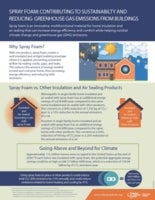Greenhouse gas (GHG) emissions and climate change are top of mind in today’s global dialogue. Scientists around the world continually seek new ways of helping reduce GHG emissions, whether they’re looking for alternative sources of energy or developing carbon-capturing technologies.
When you think of ways to reduce GHG emissions, what comes to mind? Is your focus on alternative transportation methods, greener energy sources, or reducing energy consumption? Have you ever considered that how you insulate and seal your home can help make a significant difference in reducing GHG emissions? In fact, using insulation to increase the energy efficiency of your home is one of the most effective solutions to reduce your energy usage and, in turn, GHG emissions associated with your home.
Spray foam is an innovative, multifunctional material used for home and building insulation and air sealing. Spray foam creates an airtight building envelope where applied, preventing unwanted airflow by sealing cracks, gaps, and leaks. This reduces the amount of energy or kilowatts per hour (kWh) needed to heat and cool your home, thereby increasing energy efficiency and comfort while reducing GHG emissions.
Did you know that a single-family home in Minneapolis, Minn. with ductwork in an unvented attic, insulated and air sealed with spray foam saves — on average — 5,638 kWh per year more than the same home with ductwork in a vented attic, insulated and air sealed with other products? That converts to a GHG reduction of 1,556 kilograms (kg) of carbon dioxide (CO2) per year, which is equivalent to reducing a car’s emissions by 33% annually!
What Is the Big Picture?
The U.S. Census Bureau reports that at the end of 2020, there were 141.2 million housing units available for occupancy. Statista Research Department found that 81.5% of the housing stock in the U.S. is single family. By those measures, ACC’s Martha Moore, senior director of policy analysis and statistics, concludes there are an estimated 115,000,000 single-family households in the United States.
Now, imagine if all 115,000,000 single-family homes were insulated and air sealed with spray foam instead of other products. That would be a potential aggregate energy savings of 648.37 billion kWh per year. Convert that to GHG emissions, and that would be a reduction of 178.94 billion kg of CO2 emissions per year, the equivalent of taking 38.9 million cars off the road each year.
This analysis showed that spray foam products have an environmental payback as low as 8 years compared to other insulation and air sealing products. It is generally accepted that the life span of insulation is 75 years. Accordingly, spray foam products outperform other insulation and air sealing products for up to 67 years. SPF products also continue to save energy and reduce GHG emissions year over year.
That calculation is just for single-family housing in the U.S. Consider the energy savings and GHG emissions reductions if every residential and commercial building in the U.S. is insulated and air-sealed with spray foam instead of other products…the reductions in carbon emissions could be colossal!
How Public Policy Can Support Reductions in GHG Emissions
The products of chemistry will serve as key tools to combat climate change. Foam insulation products, like spray foam, are energy efficient, resilient, and sustainable. Spray foam R-values — a measure of the effectiveness of insulation — are as high as 7.4 per inch and function as air barriers at typically installed thicknesses. ACC’s Spray Foam Coalition encourages policy makers to develop regulations that incentivize the use of insulation and air barriers to improve the energy efficiency of the thermal envelope in new construction and retrofit.
Click here to read the full SPFA analysis.
